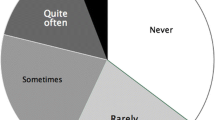Abstract
We estimated the relationship between religion and body mass index (BMI) for a general and representative sample of the Australia population. Data from the Household Income Labour Dynamics survey were analysed for 9,408 adults aged 18 and older. OLS regression analyses revealed that religious denomination was significantly related to higher BMI, after controlling for socio-demographic, health behaviours, and psychosocial variables. ‘Baptist’ men had, on average, a 1.3 higher BMI compared to those reporting no religious affiliation. Among women, ‘Non-Christians’ had, on average, a 1 unit lower BMI compared to those reporting no religious affiliation while ‘Other Christian’ women reported, on average, a 1 unit higher BMI. Our results also indicate that there was a negative relationship between religious importance and BMI among Australian women.
Similar content being viewed by others
References
ABS. (2001). Information paper: Use of the Kessler Psychological Distress Scale in ABS Health Surveys. Canberra.
ABS. (2008a). Overweight and obesity in adults 2004–05. Canberra: Australian Bureau of Statistics.
ABS. (2008b). National Health Survey: Summary of results, 2007–2008 (Reissue). Canberra.
Ayers, J. W., Richard Hofstetter, C., Irvin, V. L., Song, Y., et al. (2010). Can religion help prevent obesity? Religious messages and the prevalence of being overweight or obese among Korean women in California. Journal for the Scientific Study of Religion, 49(3), 536–549.
Baskin, M. L., Ard, J., Franklin, F., & Allison, D. B. (2005). Prevalence of obesity in the United States. Obesity Reviews, 6(1), 5–7.
Bray, G. A. (1992). Pathophysiology of obesity. The American Journal of Clinical Nutrition, 55(2), 488S–494S.
Burkhauser, R. V., & Cawley, J. (2008). Beyond BMI: The value of more accurate measures of fatness and obesity in social science research. Journal of Health Economics, 27(2), 519–529.
Cline, K. M. C., & Ferraro, K. F. (2006). Does religion increase the prevalence and incidence of obesity in adulthood? Journal for the Scientific Study of Religion, 45(2), 269–281.
Colditz, G. A. (1992). Economic costs of obesity. The American Journal of Clinical Nutrition, 55(2), 503S–507S.
Ellison, C. G., & Levin, J. S. (1998). The religion-health connection: Evidence, theory, and future directions. Health Education & Behavior, 25(6), 700–720.
Ferraro, K. F. (1998). Firm believers? Religion, body weight, and well-being. Review of Religious Research, 39(3), 224–244.
George, L. K., Ellison, C. G., & Larson, D. B. (2002). Explaining the relationships between religious involvement and health. Psychological Inquiry, 13(3), 190–200.
Gillum, R. F. (2006). Frequency of attendance at religious services, overweight, and obesity in American women and men: The Third National Health and Nutrition Examination Survey. Annals of Epidemiology, 16(9), 655–660.
Hayes, A. J., Kortt, M. A., Clarke, P. M., & Brandrup, J. D. (2008). Estimating equations to correct self-reported height and weight: Implications for prevalence of overweight and obesity in Australia. Australian and New Zealand Journal of Public Health, 32(6), 542–545.
Kim, K. H., Sobal, J., & Wethington, E. (2003). Religion and body weight. International Journal of Obesity and Related Metabolic Disorders, 27(4), 469–477.
Lapane, K. L., Lasater, T. M., Allan, C., & Carleton, R. A. (1997). Religion and cardiovascular disease risk. Journal of Religion and Health, 36(2), 155–163.
Peeters, A., Barendregt, J. J., Willekens, F., Mackenbach, J. P., et al. (2003). Obesity in adulthood and its consequences for life expectancy: A life-table analysis. Annals of Internal Medicine, 138(1), 24–32.
Pi-Sunyer, F. X. (1996). A review of long-term studies evaluating the efficacy of weight loss in ameliorating disorders associated with obesity. Clinical Therapeutics, 18(6), 1006–1035.
Spencer, E. A., Appleby, P. N., Davey, G. K., & Key, T. J. (2002). Validity of self-reported height and weight in 4808 EPIC Oxford participants. Public Health Nutrition, 5(04), 561–565.
Steinman, K. J., & Bambakidis, Athe. (2008). Faith-health collaboration in the United States: Results from a Nationally Representative Study. American Journal of Health Promotion, 22(4), 256–263.
Wooden, M., & Watson, N. (2007). The HILDA Survey and its contribution to economic and social research (So Far). Economic Record, 83(261), 208–231.
Acknowledgments
This article uses unit record data from the Household, Income and Labour Dynamics in Australia (HILDA) survey. The HILDA Project was initiated and is funded by the Australian Government Department of Families, Housing, Community Services and Indigenous Affairs (FaHCSIA) and is managed by the Melbourne Institute of Applied Economic and Social Research (MIAESR). The findings and views reported in this article, however, are those of the authors and should not be attributed to either FaHCSIA or the MIAESR.




